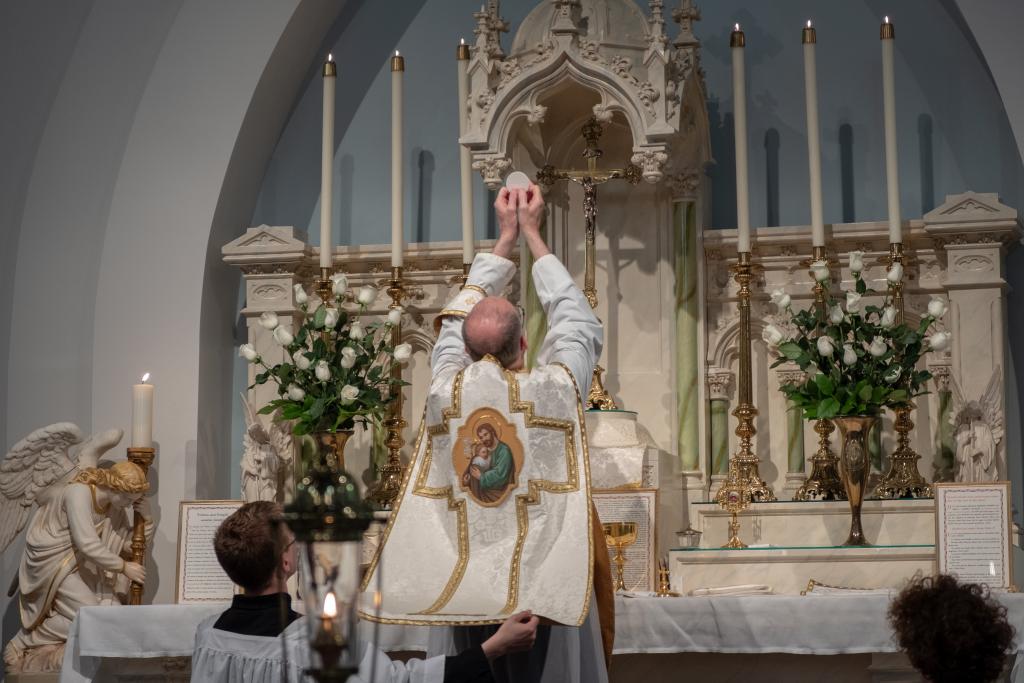The chapel veil is back.
The practice of women covering their heads at mass, which largely disappeared after Vatican II, has experienced a resurgence among traditionally-minded Catholic women, many of whom favor the Latin Mass. Many veil-wearers also desire a return to traditional gender roles and the reversal of important Vatican II doctrinal changes. Many, but not all.
I am a progressive Catholic who has grown to love the chapel veil as a personal devotional with profound theological and political significance. This is my story.

Resistance to the Chapel Veil
Like so many niche movements, I first encountered veiling on Twitter. In my understanding, veiling was rooted in women’s subjugation, as laid out in Corinthians:
But I want you to know that Christ is the head of every man, and a husband the head of his wife, and God the head of Christ. Any man who prays or prophesies with his head covered brings shame upon his head. But any woman who prays or prophesies with her head unveiled brings shame upon her head, for it is the same thing as if she had had her head shaved. 1 Corinthians Chapter 11
There’s a lot going on here. But one of the many great things about being Catholic is that we read the Bible within its historical context, and this passage was clearly intended for a specific community at a specific time. So, despite my love of lace and drama, I decided veiling couldn’t possibly be for me.
An Experiment in Holiness
But something kept drawing me back to images of women veiling. For a while, I convinced myself it was purely aesthetic. Who doesn’t like a good mantilla? But the more I reasoned myself out of it, the more I wanted to do it. Isn’t this how all adventures with God begin?
I did some research online and, of course, I came across the immensely popular retailer Veils by Lily. (This is basically the name brand of chapel veils.) On their homepage was a simple statement: “The Real Presence. It’s Why We Veil.”
I believe in the Real Presence. If that’s all it took, then why not try it as an experiment? If God wanted me to continue, I thought, He* would eventually provide answers to all my misgivings. He did.
Veiling for Humility, Not Modesty
When I first wore my new veil to mass, everyone stared at me. So much for the veil being a tool for modesty. I knew what people were thinking: I was reactionary, scrupulous, zealous, vain, and weird.

But there’s something incredibly humbling about looking a bit silly. It felt liberating, reckless, powerful, and humiliating all at once. I knew I appeared radical, but it’s good to be radical when it comes to the singular most important element of the Catholic faith: God’s presence in the Eucharist. This is especially the case when only one-third of Catholics believe in it.
I decided to humble myself for Jesus. After all, isn’t this what the whole Church should be doing?
A Godless Crisis
Recently, a friend told me the story of how he left the Catholic Church, which he had loved deeply, during the sex abuse scandal of the early 2000’s. He is far from alone. During the more recent scandal, 37% of Catholics considered leaving. The hierarchy has no one to blame but themselves. They turned away from God and in doing so destroyed lives.
Even now, those in power continue to minimize and deflect, leaving us laypeople to wonder what we can possibly do to save the Church we love. Women, who are excluded from leadership roles, feel this frustration acutely. What power do we have to demand reform within the Church when our voices are silenced? We don’t have much, but we do have the power of symbols.
A Conspicuous Call to Holiness
Veils by Lily explains, “The veil is meant to be a visible reminder of the perfect submission of the Church to the loving rule of Christ.”

The idea of submission is challenging for me. But submission to Christ is different. Submission to Christ is something we should all be doing. In fact, doing so is the only possible way to save the Church. By veiling at mass, women send a strong symbolic message: God is here in this room. This is about Jesus in the Eucharist. It’s not about power, or pride, or authority.
I am willing to humble myself, to humiliate myself even, for the sake of Jesus in the sacrament. I’m focused on Jesus. Maybe, Father, you ought to be too. Maybe the whole Church ought to be. By wearing the chapel veil women make a visual demand for holiness.
Let the Church be as holy as it’s laypeople. We dare you to repent.
The Chapel Veil as Gender Politics (It’s not what you think)
Full disclosure: I’m going to deviate from the Church’s teaching on gender in this section. I am also a layperson and I DO NOT SPEAK FOR THE CATHOLIC CHURCH. I’m claiming primacy of conscious. If you think I’m a heretic, feel free to yell at me in the comments. I’m going to keep praying about it.
That said, here’s how I rectify the very important question of veiling and gender identity.
There is such a thing as a man and a woman, and they are not the same. This must be true, because if it were not true, there would be no meaning behind concepts such as transgender or nonbinary persons. Gender must exist for individuals to cross it. A binary must exist for individuals to exist outside, between, or in it.
I, a cisgender woman, have both a female body and a gender identity of woman. However, my gender identity exists independently of my body. I know this because when I die I will still be a woman. When my body is resurrected at the end of time, my soul will rejoin with my body. But I will have been a woman throughout. I cannot be anything other than who and what I am, nor can anyone.
When I wear the veil I am making a statement about my essential womanhood. I believe God calls me to bring my gender expression to Him in the mass. It’s possible that God is calling someone who is not cisgender to bring their gender expression to Him in the mass. This would be an enormous risk that I have no right to advise anyone take. All I know is this: God calls us to bring our full selves to worship.
A Freely Chosen Personal Devotional
The veil only works if it’s optional. Because it’s optional, individual women have the power to decide if and when they want to wear it. This is a form of power: the right to worship the Lord in the manner you see fit. It’s also power to reclaim a symbol, reject past connotations, and reinvent it in a way that makes sense for you.
The Church once told women what it meant to veil. Now women are telling the Church.

*Note: I use the pronoun He for God because the historical Jesus was a man. I realize it’s more complex than this, but I’m going to leave that for another blog post.












